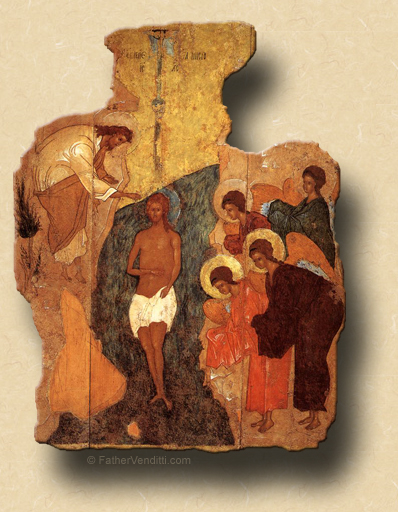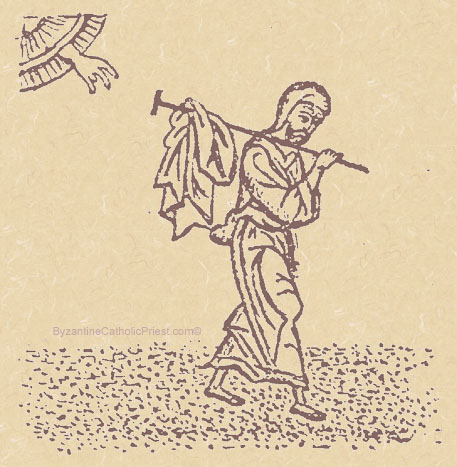Repent, for the Kingdom of God is at hand.Eph. 4:7-13; Matt. 4:12-17. The Sunday After the Theophany. Our Venerable Father George the Chozebite; our Venerable Mother Dominica; our Holy Father and Confessor Emilian.
Return to ByzantineCatholicPriest.com. |
 11:36 AM 1/8/2012 — This past week we celebrated the Feast of the Theophany, as you know. There is probably no feast on our Byzantine calendar more loaded with mystery than the Theophany. There’s certainly nothing else like it in Christendom. When I was functioning in the Latin Church, we observed a Sunday called the Feast of the Baptism of the Lord; but the Theophany goes far beyond just the commemoration of our Lord’s baptism: it is a mystical celebration of the very essence of Christianity, using the event of our Lord’s baptism as a launching pad from which to contemplate all of the spiritual and theological consequences of the incarnation of God into Man. 11:36 AM 1/8/2012 — This past week we celebrated the Feast of the Theophany, as you know. There is probably no feast on our Byzantine calendar more loaded with mystery than the Theophany. There’s certainly nothing else like it in Christendom. When I was functioning in the Latin Church, we observed a Sunday called the Feast of the Baptism of the Lord; but the Theophany goes far beyond just the commemoration of our Lord’s baptism: it is a mystical celebration of the very essence of Christianity, using the event of our Lord’s baptism as a launching pad from which to contemplate all of the spiritual and theological consequences of the incarnation of God into Man.
Today, however, it’s enough to concentrate on what this feast should mean for us as Eastern Christians. The word Theophany is Greek and means “the showing of God,” or, to put it more precisely, “God showing himself.” In the Gospel lesson of the feast, after the baptism, there is an announcement from heaven which is heard by everyone present: “This is my beloved son....” Here, God the Father shows Jesus to be his Son, thus showing him to be God as well. The Holy Spirit is also seen in the form of a dove; so it is also the first public appearance of the Holy Trinity together in one place. And from its earliest days the Church, particularly in the East, began to express this in a liturgical way. At the beginning of our Liturgy, when the Royal Doors are opened, it is a symbol of the Theophany: the opening of the doors opens the barrier between heaven and earth and reveals the Holy of Holies where God lives. The priest walks through the Royal Doors in order to proclaim the Gospel, which symbolizes God showing himself to us in order to deliver to us his word. Just before Holy Communion, the priest stands at the threshold of the Royal Doors, holds up the chalice and sings “Approach with fear of God and with faith.” It is God showing himself to us in his own body and blood in the Eucharist. When the priest turns to give a blessing, he doesn’t simply stand at the altar and turn around and bless, but he walks down through the Royal Doors to give the blessing, because even the blessing is a symbol of God showing himself to man.
Theophany means that the veil that hides heaven from us is taken away and we see God as he is. Of course, on this side of the grave none of us has a true vision of God;—we only get that on the other side of the grave—so, we have to see God through the eyes of our faith; and during the Divine Liturgy, while we are singing together the Creed, the priest holds up the Aer or large veil and waves it over the gifts because our vision of God in this life is veiled; but when the creed is almost complete he removes the veil and sets it aside because it is through the profession of our faith that we can see God face to face even in this life. When a priest dies, just before the service ends the bishop pours oil over the face of the priest and then covers it with the Aer or large veil, only this time the veil faces the other way ‘round from the way it is usually held up during the creed, because the priest who has died is now on the other side of that veil and sees God face to face.
 So, you see how the Theophany has effected so much of what we do in the Eastern Church. In fact, the Theophany is really what our religion is all about. When Christ was born, God became man; it was a Theophany. When Christ rose from the dead he appeared to his disciples; it was a Theophany. The feast of the Theophany is really every other feast of the Church rolled into one. It could just as easily be called the feast of Revelation itself; and it is symbolized in that one event which the Church presented to us on the feast: when God, in the person of Jesus, went to the River Jordan and was baptized by John, and the Father announced his love for the Son, and the Holy Spirit appeared as a dove. But it is not simply the one event of our Lord’s baptism that is being celebrated. It is the whole phenomenon of God showing himself to man: in his birth, in his life, in his passion, in his death, in his resurrection, in his Church, in his Holy Mysteries, and most particularly in the Holy Eucharist. So, you see how the Theophany has effected so much of what we do in the Eastern Church. In fact, the Theophany is really what our religion is all about. When Christ was born, God became man; it was a Theophany. When Christ rose from the dead he appeared to his disciples; it was a Theophany. The feast of the Theophany is really every other feast of the Church rolled into one. It could just as easily be called the feast of Revelation itself; and it is symbolized in that one event which the Church presented to us on the feast: when God, in the person of Jesus, went to the River Jordan and was baptized by John, and the Father announced his love for the Son, and the Holy Spirit appeared as a dove. But it is not simply the one event of our Lord’s baptism that is being celebrated. It is the whole phenomenon of God showing himself to man: in his birth, in his life, in his passion, in his death, in his resurrection, in his Church, in his Holy Mysteries, and most particularly in the Holy Eucharist.
In the early Church, in the East, it was on Theophany Day that converts were often baptized, inspired by the example of our Lord’s own baptism by John. And to this day we mark the feast of the Theophany with the blessing of water. The priest blesses the church and then blesses us with the water; then we take the Theophany water to our homes as a means of taking God with us into our lives. But that water is not meant to be some kind of lucky charm that we take home to protect us from evil. That would not be faith, that would be superstition. We take the water home with us as an expression of our desire that God make his home within us, which only happens when we live Godly and holy lives. Being blessed with the water of the Theophany does not make us holy. It’s being holy that makes the blessing with the water of the Theophany mean something. The whole idea is that, since God has shown himself to us in all these different ways celebrated by our Church, we will now go forth and show God to everyone we meet through living holy Christian lives.
In a very convenient way, today's Gospel lesson shows us what the aftermath of celebrating the Theophany should be: Jesus the Man puts sandals on his feet, throws a pack on his back, and begins to trudge the width and breadth of Galilee preaching to everyone he meets along the way. And what does he preach? “Repent, for the Kingdom of God is at hand.”
Father Michael Venditti
|

